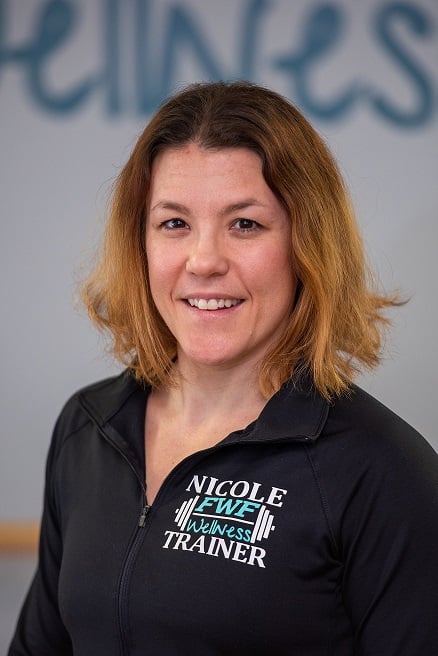Many of us (and our clients) have a fixation on the weight scale. We judge our fitness, progress, and unfortunately, at times, self-worth, based on that number that appears on the scale when we step on it first thing in the morning.
While the bathroom scale can be a useful tool in screening ourselves for obesity or tracking weight loss progress, it can be truly deceiving for many of us. This includes athletes with a higher-than-normal weight, as well as individuals who are skinny fat, especially when it reassures them, that they are a healthy weight.
You can measure your BMI with the NASM BMI Calculator!
A Word on BMI
We must discuss the concept of BMI and body composition to understand normal weight obesity. Body Mass Index (BMI) is the most common means of measuring comparing weight and height to determine adiposity. Lambert Adolphe Jacques Quetelet, a Belgian astronomer, and statistician created the measurement in the 1830s to determine if an individual’s weight was normal as compared to their height. BMI does not take body frame size into account.
BMI is still used frequently for individuals and populations where a normal reading is between 18 and 24.99 kg/square meters. This is a useful metric to use as a screening tool, or on a population scale, however, it may be useless for some individuals. Likewise, some argue that BMI is an outdated measurement system to determine a healthy weight (Summerfield, 2016)
What is Body Composition?
Body composition is the proportion of lean body mass (water, bone, organs, and muscle tissue) as compared to adipose tissue (fat mass) in the body. With the advent of bioimpedance analysis (e.g., the InBody™) and, dual-energy X-ray absorptiometry (DEXA), it is more common for health seekers and fitness enthusiasts to get an idea of their body composition rather than relying on BMI measurements (Duren et al., 2008).
Yes, it is entirely possible to have a normal or below normal weight and still have body fat levels that are in the unhealthy zone (i.e., skinny fat). Likewise, it is possible, and even common in strength and power-based sports, to have a body mass index (BMI) in the overweight category yet have very healthy if not low levels of body fat. In my practice, I have seen athletes with 5 or 6 percent body fat and a BMI of 30, and older adults with a BMI of 20 with 40 percent body fat. Which of these individuals carries the true health risk?
What is a “Skinny Fat” Body Type?
The term skinny fat or normal weight obesity (NWO) refers to a person who is normal or below normal weight but has a higher than optimal body fat percentage and often lower than optimal lean body mass. A person with a skinny fat body type can have very high amounts of body fat as compared to a lean body mass.
Frequently, these individuals have high levels of visceral (deep abdominal) rather than subcutaneous (under the skin) fat deposits. NWO affects more than 30 million Americans. Adults affected by normal weight obesity have a four-fold risk of cardiac and metabolic diseases (Correa-Rodríguez et al., 2020).
See also: Body Types - How to Train & Diet for Your Somatotype
Health Concerns with a Skinny Fat Body Type
NWO is often linked to insulin resistance, accumulation of visceral (abdominal) fat, and further decreases in lean body mass. This body type is also associated with the same metabolic derangements commonly seen in obese individuals such as hypertension, low cardiorespiratory fitness, unfavorable lipid profiles (i.e., high cholesterol and triglycerides), and high levels of inflammatory markers.
Metabolic dysfunction of this degree can be linked to diabetes, cancer, and heart disease (Ding et al., 2016). In the elderly, this condition is often referred to as sarcopenic obesity as it is related to a significant decline in skeletal muscle mass (and bone mass) often leading to orthopedic injuries, inability to remain independent, and overall frailty (Ardeljan & Hurezeanu, 2022).
What Causes One to Become ‘Skinny Fat’?
Like most things, genetics, and lifestyle both play a role in developing NWO. Some individuals are genetically prone to the condition as they tend to store more visceral fat (abdominal fat) and less subcutaneous fat (fat under the skin) than their normal weight, metabolically healthy, counterparts. In these cases, it is easier for these individuals to reach an unhealthy amount of body fat before their BMI indicates they are even overweight (Yaghootkar et al., 2014).
However, genetics is not fully to blame. The same lifestyle choices that lead to obesity can lead to normal weight obesity. This is including but is not limited to poor dietary choices (higher than ideal consumption of fats and carbohydrates coupled with low protein intake), poor sleep, high stress, and lack of exercise. It is important to highlight the role of lack of exercise, especially resistance training when examining the cause of normal weight obesity as low skeletal muscle mass can be a driver in developing NWO.
If you are an adult with a relatively sedentary lifestyle, it may be a good idea to obtain body composition testing rather than relying on BMI to see if you may be at risk for NWO, especially with increasing age (Więch et al., 2021).
How to Manage Normal Weight Obesity?
The management of NWO is more complex than simply advising a client or patient to lose weight. The weight of individuals with a skinny fat body type is not the problem. Rather, a body composition defined by low lean body mass coupled with a high-fat mass is the issue. Simply advising these clients to lose weight will often result in muscle loss and exacerbation of the skinny fat body type. What is the best way to manage NWO?
Management Tip #1: Exercise, But Not Just Moving More
Simply moving more may not be enough in cases of NWO. Cardiorespiratory-based exercises such as walking, cycling, dance, running, and swimming can be beneficial for increasing daily energy expenditure, improving cardiorespiratory health, and reducing fat mass, but should not be used exclusively in this population as the body will need more stimulus to increase lean body mass.
Rather, resistance training should be prioritized to build skeletal muscle and bone mass, and light weights and high repetitions are not the answer. Instead, the body must be exposed to loads and mechanical stress that exceeds what is needed for everyday living (Law et al., 2016). Although resistance training should be properly periodized (phased through stabilization, endurance, and strength training), a focus on higher loads, lower repetition, and explosive movements are often programmed in the hypertrophy, maximum strength, and power phases of the OPT model should be incorporated to drive bone turnover and increases in skeletal muscle mass (Clark et al., 2014).
Management Tip #2: Clean Up Your Diet, but Don’t Diet
Optimal nutrition practice is key in reversing a skinny fat body type. Significant caloric deficits will often lead to more loss of lean body mass in these individuals. If fat loss is desired, small caloric deficits coupled with a high protein intake can help support optimal body composition. Intakes of 1.2 to 1.5 g/kg of body weight per day help support increases in lean body mass and reduction in fat mass.
This is especially true in older adults (Kim et al., 2016). Likewise, consuming a diet moderate in fats and carbohydrates, reducing intakes of refined sugar, and ensuring adequate fiber intake (25 g per day for females and 35 g per day for males) can also help in achieving a more favorable body composition (Willoughby et al., 2018).
Management Tip #3: Reduce Stress and Inflammation
Remember that NWO is often associated with a pro-inflammatory state. Getting adequate sleep (7 to 8 hours per night), taking time to unwind, and practicing good cortisol-reducing habits (see How to Lower Cortisol: 8 Ways to Regulate Cortisol) will also aid in the management of NWO.
Final Thoughts
BMI can be very misleading in cases of NWO (skinny fat body type). Adults who are sedentary and suspect they may have skinny fat body types should consider a body composition reading in addition to routine health screenings.
Individuals with NWO should focus on increasing lean body mass via resistance training, appropriate dietary changes, and stress reduction techniques to improve body composition rather than simply attempting to lose weight. Get your protein, get your steps, get your sleep, and lift heavy things!
References
Ardeljan, A. D., & Hurezeanu, R. (2022). Sarcopenia. PubMed; StatPearls Publishing. https://www.ncbi.nlm.nih.gov/books/NBK560813/#:~:text=Insulin%20resistance%20with%20%E2%80%9Csarcopenic%20obesity
Clark, M. A., Lucett, S. C., & Sutton, B. (2014). NASM essentials of personal fitness training. Burlington Jones & Bartlett Learning.
Correa-Rodríguez, M., González-Ruíz, K., Rincón-Pabón, D., Izquierdo, M., García-Hermoso, A., Agostinis-Sobrinho, C., Sánchez-Capacho, N., Roa-Cubaque, M. A., & Ramírez-Vélez, R. (2020). Normal-Weight Obesity Is Associated with Increased Cardiometabolic Risk in Young Adults. Nutrients, 12(4), 1106. https://doi.org/10.3390/nu12041106
Ding, C., Chan, Z., & Magkos, F. (2016). Lean, but not healthy. Current Opinion in Clinical Nutrition and Metabolic Care, 19(6), 408–417. https://doi.org/10.1097/mco.0000000000000317
Duren, D. L., Sherwood, R. J., Czerwinski, S. A., Lee, M., Choh, A. C., Siervogel, R. M., & Cameron Chumlea, Wm. (2008). Body Composition Methods: Comparisons and Interpretation. Journal of Diabetes Science and Technology (Online), 2(6), 1139–1146. https://www.ncbi.nlm.nih.gov/pmc/articles/PMC2769821/
Kim, J. E., O’Connor, L. E., Sands, L. P., Slebodnik, M. B., & Campbell, W. W. (2016). Effects of dietary protein intake on body composition changes after weight loss in older adults: a systematic review and meta-analysis. Nutrition Reviews, 74(3), 210–224. https://doi.org/10.1093/nutrit/nuv065
Law, T. D., Clark, L. A., & Clark, B. C. (2016). Resistance Exercise to Prevent and Manage Sarcopenia and Dynapenia. Annual Review of Gerontology and Geriatrics, 36(1), 205–228. https://doi.org/10.1891/0198-8794.36.205
Summerfield, L. (2016). Nutrition, exercise, and behavior : an integrated approach to weight management. Wadsworth Cengage Learning.
Więch, P., Chmiel, Z., Bazaliński, D., Sobolewski, M., & Sałacińska, I. (2021). Body Composition and Selected Nutritional Indicators in Healthy Adults-A Cross-Sectional Study. Global Advances in Health and Medicine, 10, 21649561211021794. https://doi.org/10.1177/21649561211021794
Willoughby, D., Hewlings, S., & Kalman, D. (2018). Body Composition Changes in Weight Loss: Strategies and Supplementation for Maintaining Lean Body Mass, a Brief Review. Nutrients, 10(12), 1876. https://doi.org/10.3390/nu10121876
Yaghootkar, H., Scott, R. A., White, C. C., Zhang, W., Speliotes, E., Munroe, P. B., Ehret, G. B., Bis, J. C., Fox, C. S., Walker, M., Borecki, I. B., Knowles, J. W., Yerges-Armstrong, L., Ohlsson, C., Perry, J. R. B., Chambers, J. C., Kooner, J. S., Franceschini, N., Langenberg, C., & Hivert, M.-F. . (2014). Genetic Evidence for a Normal-Weight “Metabolically Obese” Phenotype Linking Insulin Resistance, Hypertension, Coronary Artery Disease, and Type 2 Diabetes. Diabetes, 63(12), 4369–4377. https://doi.org/10.2337/db14-0318












